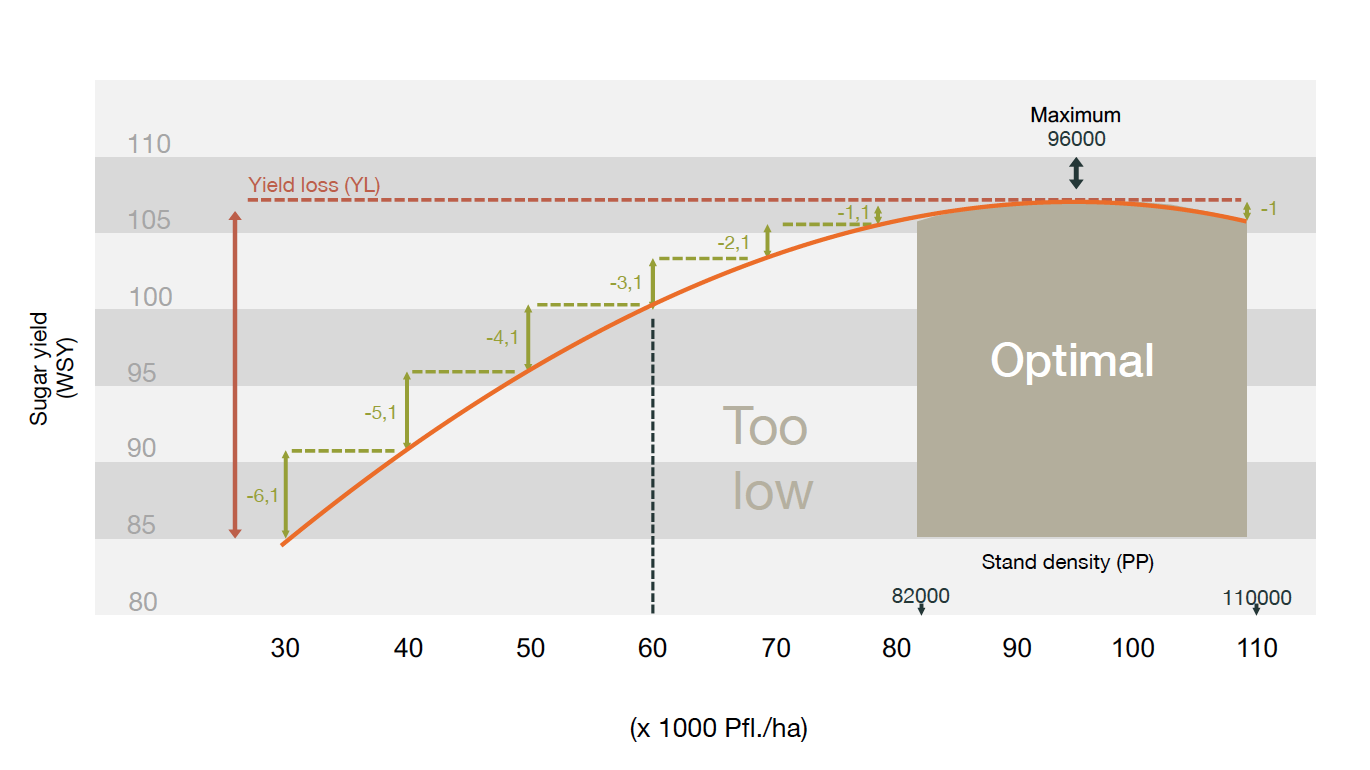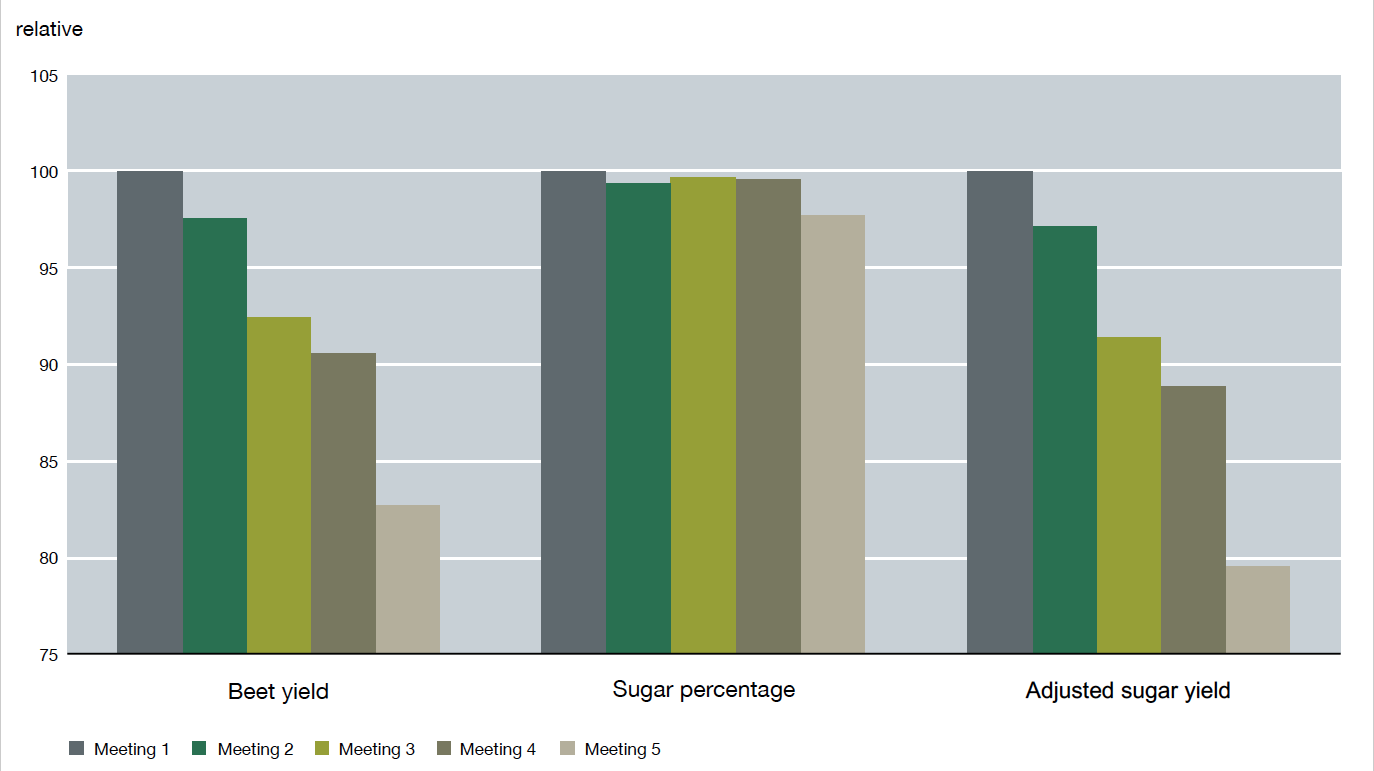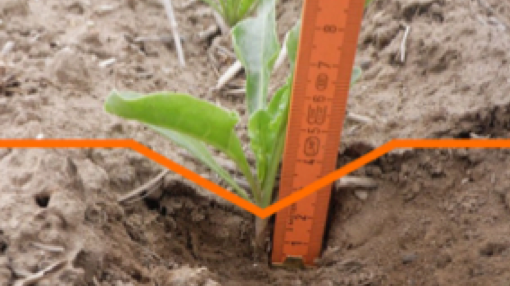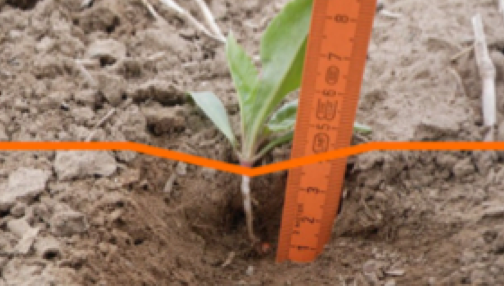Helpful tips and advice on optimal sowing of sugarbeets
Sowing - the foundation for your success
To achieve maximum sugar yields, you should aim for a plant density of 80,000 to 100,000 plants/ha to harvest.
On the way to optimal plant density, you should keep in mind the possibility of losses, e.g., due to freezing, pests, siltation etc., and choose a seed rate of about 110,000 pellets/ha. Depending on your desired crop density, you will reach a:
- Final distance between beet pellets of 18-22 cm
- Row distance: 45 or 50 cm
Do your own check on the development of your crop by setting up a counting track:
- Helpful under difficult emergence conditions
- Total counted area should be 10 m²:
- At 45 cm row distance: 2 rows of 11.11 m each
- at 50 cm row distance: 2 rows of 10.00 m each
- Multiply by 1000 to determine the plant population per hectare
| 45 cm row distance | |||||||
| Field emergence (%) | |||||||
| Seed spacing in the row | Sowing in pill per ha | 70 | 75 | 80 | 85 | 90 | 95 |
|
|
Number of plants [1000/ha] | ||||||
| 16 | 139 | 97 | 104 | 11 | 118 | 125 | 132 |
| 16.5 | 135 | 94 | 101 | 108 | 114 | 121 | 128 |
| 17 | 131 | 92 | 98 | 105 | 111 | 118 | 124 |
| 17.5 | 127 | 89 | 95 | 102 | 108 | 114 | 121 |
| 18 | 123 | 86 | 93 | 99 | 105 | 111 | 117 |
| 18.5 | 120 | 84 | 90 | 96 | 105 | 108 | 114 |
| 19 | 117 | 82 | 88 | 94 | 99 | 105 | 111 |
| 19.5 | 114 | 80 | 85 | 91 | 97 | 103 | 108 |
| 20 | 111 | 78 | 83 | 89 | 94 | 100 | 106 |
| 20.5 | 108 | 76 | 81 | 87 | 92 | 98 | 103 |
| 21 | 106 | 74 | 79 | 85 | 90 | 95 | 101 |
| 21.5 | 103 | 72 | 78 | 83 | 88 | 93 | 98 |
| 22 | 101 | 17 | 76 | 81 | 86 | 91 | 96 |
| 22.5 | 99 | 69 | 74 | 79 | 84 | 89 | 92 |
| 23 | 97 | 68 | 72 | 77 | 82 | 87 | 92 |
| 50 cm row distance | |||||||
| Field emergence (%) | |||||||
| Seed spacing in the row | Sowing in pill per ha | 70 | 75 | 80 | 85 | 90 | 95 |
| Number of plants [1000/ha] | |||||||
| 16 | 125 | 88 | 94 | 100 | 106 | 113 | 119 |
| 16.5 | 121 | 85 | 91 | 97 | 103 | 109 | 115 |
| 17 | 118 | 82 | 88 | 94 | 100 | 106 | 112 |
| 17.5 | 114 | 80 | 86 | 91 | 97 | 103 | 109 |
| 18 | 111 | 78 | 83 | 89 | 94 | 100 | 106 |
| 18.5 | 108 | 76 | 81 | 86 | 92 | 97 | 106 |
| 19 | 105 | 74 | 79 | 84 | 89 | 95 | 100 |
| 19.5 | 103 | 72 | 77 | 82 | 87 | 92 | 97 |
| 20 | 100 | 70 | 75 | 80 | 85 | 90 | 95 |
| 20.5 | 98 | 68 | 73 | 78 | 83 | 88 | 93 |
| 21 | 95 | 67 | 71 | 76 | 81 | 86 | 90 |
| 21.5 | 93 | 65 | 70 | 74 | 79 | 84 | 88 |
| 22 | 91 | 64 | 68 | 73 | 77 | 82 | 86 |
| 22.5 | 89 | 62 | 67 | 71 | 76 | 80 | 84 |
| 23 | 87 | 61 | 65 | 70 | 74 | 78 | 83 |
Sowing times for sugarbeets: As early as possible, as late as necessary!
To achieve high yields in the sugarbeet harvest, sowing should be done as early as possible. The later the sowing is done, the lower is the possible yield. However, note that: “Seedbed precedes sowing time”
Therefore:
- Sowing is generally optimal between mid-March and mid-April
- But be cautious in regions with a risk of late frost! Beets are especially sensitive to the effects of frost in the cotyledon stage
An additional important criterion determining the sowing time is the soil temperature. Germination of beet seeds begins at 5 - 6°C, but temperatures of 10 - 12°C are required for rapid and uniform emergence.








